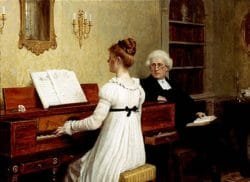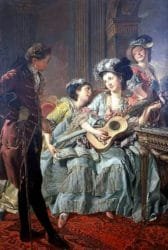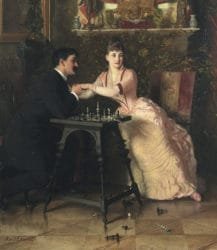Courtship and Marriage in Jane Austen’s World
The Book of Common Prayer (1662) made clear why (and why not) a couple should marry:
(Marriage) is not by any to be enterprised, nor taken in hand, unadvisedly, lightly, or wantonly, to satisfy men’s carnal lusts and appetites, like brute beasts that have no understanding; but reverently, discreetly, advisedly, soberly, and in the fear of God; duly considering the causes for which Matrimony was ordained.
First, It was ordained for the procreation of children, to be brought up in the fear and nurture of the Lord, and to the praise of his holy Name.
Secondly, It was ordained for a remedy against sin, and to avoid fornication; that such persons as have not the gift of continency might marry, and keep themselves undefiled members of Christ’s body.
Thirdly, It was ordained for the mutual society, help, and comfort, that the one ought to have of the other, both in prosperity and adversity.
However, nothing so intimately connected with the human heart could ever be so simple.
Decline of Arranged Marriage
Throughout history, parents used their children, both daughters and sons, in arranged marriages as assets in their efforts to gain and maintain wealth, connections, and power. Growing up knowing your destiny is to be a pawn in your parents machinations is such a great foundation for marriage, isn’t it?
Luckily for all of us, the Age of Enlightenment (18th century) brought a radical shift in attitudes toward marriage. Ideas of human freedom and equality meant that marriage should be a matter of individual choice, not parental mandate.
The idea that a daughter would marry according to her father’s choice fell out of fashion, and a man who would force a young woman into a disagreeable partnership was deemed contemptible. The new way of the world was for young people to make their own marriage choices with parents left with (hopefully) the right to veto socially or economically unsuitable candidates. Or at least that was the theory.
 Arranged marriage lingered longest among the upper classes, who had the most at stake with respect to money, property and rank in society. Within this group, it was assumed a young woman would learn to love, or at least tolerate, the husband chosen by her father, since after all, he was the best suited to make such a decision for her. This attitude is reflected in Jane Austen’s Lady Catherine as she and her sister decide that their eldest offspring should wed even while they are still babes in arms.
Arranged marriage lingered longest among the upper classes, who had the most at stake with respect to money, property and rank in society. Within this group, it was assumed a young woman would learn to love, or at least tolerate, the husband chosen by her father, since after all, he was the best suited to make such a decision for her. This attitude is reflected in Jane Austen’s Lady Catherine as she and her sister decide that their eldest offspring should wed even while they are still babes in arms.
Even so, few high society parents contrived totally mercenary alliances for their children. Conversely, not all gentry families permitted their offspring to marry as they chose. Eldest sons, who were set to inherit family lands and fortunes (and who would likely be the ones to provide for his parents in their dotage), found themselves subject to more parental sanctions than younger siblings. Young women with unmarried sisters or mothers who anticipated an impoverished widowhood might also encounter greater amounts of parental intrusion in their marital choices. Without social programs like welfare or social security, unmarried females in need of support would turn first to brothers and sons, including in-laws, for support. Hence the pressure upon Pride and Prejudice’s Bennet sisters that one of them had to marry very well indeed.
In the midst of all these changes, society at large recognized that marriages based on compatibility, affection, and even love, were more likely to stand the test of time than marriages arranged purely for material gain. Score one for love, right?
This new attitude complicated matters for parents–or perhaps sent them into all out panic. Now they had to engineer circumstances for their daughters to meet the right sort of eligible men. The perceived rarity of such men encouraged something of a husband-hunting hysteria among parents eager to see their daughters well-settled. (Not to mention financially stable in an establishment of their own.)
These perceptions were not entirely unfounded. The ravages of war (thanks, Napoleon) and higher male infant mortality rates during the latter part of the eighteenth century and early nineteenth resulted in an imbalance in the numbers of males and females. Moreover, the high cost of maintaining a household and the antics of avid man-hunters put young men off the notion of marriage, further reducing the pool of available bachelors.
The Duty of Virgins
Despite the new attitudes of the Enlightenment, one overarching truth remained unchanged. A woman was nothing without a husband. (In truth she was legally nothing WITH a husband, but that’s another post.)
It was the duty of a young woman to marry. The Whole Duty of a Woman suggested that there were three acceptable ‘States and Conditions’ of womanhood: the virgin, the married and the widowed. Woe to she who remained unmarried: “An old Maid is now thought such a Curse as no Poetic Fury can exceed, look’d on as the most calamitous Creature in Nature.”
To avoid that dreaded state of spinsterhood, a girl needed to make a sensible match. What constituted a sensible match? In short, one which provided three key qualities: connections, cash and compatibility.

Connections
During the late Georgian and Regency eras, everyone knew their rank in society and where they stood in relation to everyone else in their social circles. Unions between equals were expected, and in many families required, hence the desirability for the match between William Elliot and Elizabeth Elliot (or Anne Elliot for that matter) in Persuasion.
Perish the thought of allowing an individual of inferior social standing into the family circle, and thus the social circle. Such an act was considered no less than a betrayal of those within their strata. In Pride and Prejudice, Charles Bingley’s sisters and his friend, Mr. Darcy tried to use this argument to dissuade him away from Jane Bennet.
Consequently, particularly among the upper classes people often married partners with whom their family enjoyed alliances, or to whom they were related. Marriage between first cousins, neither forbidden by the church nor law, were common. (Aren’t we all glad that’s changed?)
Misalliances were considered base. A girl should marry to increase her social consequence and thereby her family’s. A good match satisfied a range of criteria, including family advancement, the ideal of parity, character and affection.
A young woman should never marry beneath her. Matches between men and women of unequal social standing were threats to the rigid structure of society. This was the mistake of Fanny Price’s mother in Mansfield Park.
Cash
Connections were not the only criteria. Many titled and influential families were plagued by declining fortune. The lure of pedigree lost some of its luster when tarnished by debt. Consequently many young men with connections were searching for heiresses to shore up failing family finances. Austen’s Georgiana Darcy, Caroline Bingley and Emma would all have been prey for such a suitor.
If a young man’s family was facing financial ruin or hardship, it was his duty to marry money no matter how unattractive the package that wrapped it. Can’t you see the lonely-hearts advert now: Single gentleman seeking young lady with at least ten thousand pounds. Willing to provide an elegant array of connections. How romantic.
This explains some of General Tilney’s rage at his discovery of Catherine Morland’s lack of fortune in Northanger Abby. No doubt he was already eyeing the potential contributions she could make to the family coffers when he invited her to visit with them.
Not surprisingly, young people of both genders were actively warned away from fortune-hunters.
 The more money and property one had, the greater the burden to make a ‘convenient’ match. So the pressure was greatest on eldest sons to marry a woman with appropriate assets. A young lady of a similarly great family might decide to sacrifice herself on the altar of family duty to help pay off family debts (gambling or otherwise) or establish favorable connections. In Pride and Prejudice, Lady Catherine asserts that her nephew, Mr. Darcy, should marry her daughter Anne to unite the two grand estates into something even grander.
The more money and property one had, the greater the burden to make a ‘convenient’ match. So the pressure was greatest on eldest sons to marry a woman with appropriate assets. A young lady of a similarly great family might decide to sacrifice herself on the altar of family duty to help pay off family debts (gambling or otherwise) or establish favorable connections. In Pride and Prejudice, Lady Catherine asserts that her nephew, Mr. Darcy, should marry her daughter Anne to unite the two grand estates into something even grander.
As in most things, there was some flexibility in the rules. A wealthy man might be excused for marrying a poorer woman, particularly if she were pretty and had good manners. Hence, in Austen’s Sense and Sensibility, Col. Brandon’s seeking Marianne is considered a smart match by the Middletons.
Woe to the plain girl with little fortune, like Pride and Prejudice’s Charlotte Lucas. She was among the least desirable of creatures. Despite her connections, her father’s financial situation puts Anne Elliot of Persuasion in a similar condition.
However, a wealthy woman of any age would be thought to have thrown herself away to marry a man of lesser means. Thus, in Pride and Prejudice, Mary King’s family sends her away to keep her from throwing herself away on Wickham, and Darcy works to prevent his sister Georgiana from doing the same.
Compatibility
Why might a woman ‘throw herself away?’ Often, because she fancied herself in love.
Corbould (1834) wrote:
Most women are inclined to romance. This tendency is not confined to the young or to the beautiful; to the intellectual, or to the refined.— Every woman capable of strong feeling is susceptible of romance; and though its degree may depend on external circumstances, or education, or station, or excitement, it generally exists, and requires only a stimulus for its development.
Romance is, indeed, the charm of female character. …(but) It is associated in the minds of many with folly alone.
The idea of marrying for love had gained ground by this era, possibly fueled by the increase in novel reading, horror of horrors.
However, showing too much passion for one’s spouse was considered in poor taste. A marriage decision based on passion alone was not expected to be a correct one. Young people were advised to pursue friendship and domestic compatibility instead.
Choosing Wisely
“How wretched must be a woman, united to a man whom she does not prefer to every other in the world. What secret preferences must steal into her heart! What unquiet thoughts take possession of her fancy! And what can men of principle call such an act, but legal prostitution.” Bennett (1811)
“Marriage enlarges the scene of our happiness and miseries. A marriage of love is pleasant; a marriage of interest easy; and a marriage where both meet, happy. A happy marriage has in it all the pleasures of friendship, all the enjoyments of sense and reason; and, indeed, all the sweets of life.” The Young Husband’s Book (1839)
Since divorce was virtually unavailable, marrying the wrong person could lead to a life of misery for both partners. Advice for choosing well abounded.
The Young Husband’s Book (1839) cautioned young men to avoid women of bad reputation, low status, those who loved money, or were stupid.
John Bennett (1811) in his Letters to a Young Lady offered more detailed advice:
(T)here are a few general principles of most essential consequence to regulate your choice…Fortune surely should be considered. It were absurd to think of love, where there is not some prospect of a decent provision for your probable descendants. That decency depends on birth, habit and education. But if you can compass the other requisites, be as moderate as possible, in your demands of fortune…
Never suffer yourself to think of a person, who has not religious principle. A good man alone is capable of true attachment, fidelity and affection. …
The next thing you should look for is a person of a domestic cast. This will, most frequently, be found in men of the most virtuous hearts and improved understandings. …
The last thing, though I do not mention it, as absolutely necessary, yet highly desirable in a person, with whom you must spend all your days, is sentiment and taste. …
Though a woman, before this union, may be admired for her accomplishments … yet after it, we expect her character to display something more substantial. To a man, who must spend his days in her company, all these little superficial decorations will speedily become insipid and unimportant. Love must be preserved by the qualities of the heart, and esteem secured by the domestic virtues… He wants a person who will kindly divide and alleviate his cares, and prudently arrange his household concerns. He seeks not a coquette, a fashionist, a flirt, but a comfortable assistant, companion and friend.
But how did one meet and win such a partner? Unfortunately, the Enlightenment provided little direction as to managing the practicalities of this new way of marriage. New rules evolved to assist parents and their marriage-ready offspring navigate the difficult process of meeting potential partners.
Find more on Regency Era Courtship here.
Find more on Regency Era Weddings here
Find more on Regency Era Marriage Here
Find the Regency Index here.
References
A Master-Key to the Rich Ladies Treasury or The Widower and Batchelor’s Directory by a Younger Brother, published in 1742.
Austen, Jane (1813) Pride and Prejudice
Bates, Denise Breach of Promise to Marry Research – New Discoveries http://www.denisebates.co.uk/bopdiscoveries.html
Bates, Denise Breach of Promise to Marry Research – Facts and Figureshttp://www.denisebates.co.uk/bopfacts.html
Bennett, John. Letters to a Young Lady, on a Variety of Useful and Interesting Subjects Calculated to Improve the Heart, to Form the Manners and Enlighten the Understanding. “That Our Daughters May Be as Polished Corners of the Temple.” 6th American ed. Hudson: Printed by William E Norman, 1811.
The Book of Common Prayer and Administration of the Sacraments and Other Rites and Ceremonies of the Church, According to the Use of the Church of England: Together with the Psalter or Psalms of David, Pointed as They Are to Be Sung or Said in Churches: The Form and Manner of Making, Ordaining, and Consecrating of Bishops, Priests, and Deacons. Cambridge: Printed by John Field, 1662. http://www.eskimo.com/~lhowell/bcp1662/intro/contents.html
Corbould, Edward Henry. The Young Lady’s Own Book a Manual of Intellectual Improvement and Moral Deportment. Philadelphia: Key & Biddle, 1834.
Davidoff, Leonore & Hall, Catherine. Family Fortunes: Men and Women of the English Middle Class 1780-1850. Routledge (2002)
Erickson, Amy. Women and property in early modern England (1993)
Gener, S., and John Muckersy. M. Gener, Or, A Selection of Letters on Life and Manners. 3rd ed. Edinburgh: Printed for Peter Hill …, A. Constable & and A. MacKay ;, 1812.
Gregory, John. A Father’s Legacy to His Daughters By the Late Dr. Gregory, of Edinburgh. The 2nd ed. London: Printed for W. Strahan ;, 1774.
Heydt-Stevenson, Jill (2005) Austen’s Unbecoming Conjunctions: Palgrave Macmillan
Jones, Hazel. Jane Austen and Marriage. London: Continuum, 2009.
Le Faye, Deirdre. Jane Austen: The World of Her Novels. Harry N. Abrams (2002)
Lewis, Judith Schneid (1986) In the Family Way, Childbearing in the British Aristocracy, 1760-1860: Rutgers University Press
Morning Post, December 19, 1822.
Morning Post, November 27, 1811.
Revel, Rachel (1825) ‘Winter Evening Pastimes or The Merry Maker’s Companion’
Shapard, David M.,ed.(2011) – The Annotated Sense and Sensibility: Anchor Books
Shoemaker, Robert B. (1998) Gender in English Society 1650-1850: Pearson Education Limited
Sullivan, Margaret C. The Jane Austen Handbook .Quirk Books (2007)
The Whole Duty of a Woman, Or, an Infallible Guide to the Fair Sex. Containing, Rules, Directions, and Observations, for Their Conduct and Behaviour through All Ages and Circumstances of Life, as Virgins, Wives, or Widows. With Directions, How to Obtain All Use. The 2nd ed. London: Printed for T. Read, in Dogwell-Court, White-Fryers, Fleet-Street, 1737.
The Young Husband’s Book a Manual of the Duties, Moral, Religious, and Domestic, Imposed by the Relations of Married Life. Philadelphia: Lea & Blanchard, 1839.
Vickery, Amanda. Behind Closed Doors: At Home in Georgian England. New Haven, Conn.: Yale University Press, 2009.
Vickery, Amanda. The Gentleman’s Daughter. Yale University Press (1998)
William Blackstone. Commentaries on the Laws of England. Vol, 1 (1765), pages 442-445.


Comments
Courtship and Marriage in Jane Austen’s World — No Comments
HTML tags allowed in your comment: <a href="" title=""> <abbr title=""> <acronym title=""> <b> <blockquote cite=""> <cite> <code> <del datetime=""> <em> <i> <q cite=""> <s> <strike> <strong>